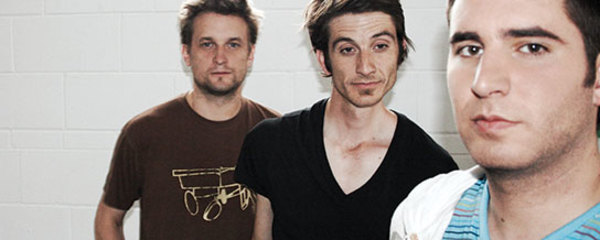Cobblestone Jazz: The Spaces Between
When Tyger Dhula and Danuel Tate moved to Montreal at the tail end of the […]
Cobblestone Jazz: The Spaces Between
When Tyger Dhula and Danuel Tate moved to Montreal at the tail end of the […]

When Tyger Dhula and Danuel Tate moved to Montreal at the tail end of the ’90s, the pair was practically penniless, with no choice but to live in an old converted factory with other (literally) starving artists.
This was fine for the first four months–inspiring, even–as they toyed with techno and jazz motifs alongside longtime collaborator Colin de la Plante (a.k.a. The Mole). Together, they laid the foundations for what would become–with the addition of techno DJ/producer Mathew Jonson–the Modern Deep Left Quartet, and later, the groundbreaking trio Cobblestone Jazz.
Too bad an armed robbery had to go and ruin it all.
“Some guys pinned us down and pressed guns against our heads one night,” says Tate. “They took all of our equipment. We basically went back home [to Vancouver] with our tails between our legs and The Mole stayed because his roots are in Montreal.”
While their situation seemed ominous and overwhelming at the time, it forced Dhula, Tate, and longtime friend Jonson to focus even harder on the concept behind Cobblestone Jazz. Throughout the ’90s, the three casually played around Vancouver under band names and pretenses that changed nightly. There was always one recurring theme, though: trying to add a blunted Blue Note vibe to the pulse of electronic dance music.
“In the beginning, we played whatever we wanted,” explains Jonson of the fledgling Cobblestone Jazz. “It could be a jazz ballad for 25 minutes or drum & bass. Sometimes not all of us were into it, but we still tried to have fun and be open to new ideas.”
Feeling It Out
After live performances from the Montreux Jazz Festival to MUTEK and a series of single releases–notably their 2002 debut, the 5th Element EP, and the distorted and dazed four-on-the-floor sucker punch of 2006’s “Dump Truck” and “India In Me” (on their own Itiswhatitis and Wagon Repair labels, respectively)–Cobblestone Jazz released their first full-length, 23 Seconds, last month. The album is a striking display of the band’s future-forward palette and approach, which applies Tate’s traditional Rhodes rolls and improvisational jazz technique to Jonson’s and Dhula’s analog racks (synths, drum machines, samplers) and simple computer setups. This doesn’t come out of nowhere: Jonson was a jazz drummer well before he produced twisted techno tracks for Perlon, Minus, and Kompakt; Tate’s a jazz musician who has played keyboards for the past 15 years.
To emphasize the smoky lounge portion of the equation, the trio improvises their tracks to a live stereo mix while facing one another, a technique that leads to a lot of alternate takes. “We just feel it out as we go,” explains Jonson. “It’s all about listening to what is happening inside the spaces of everyone else’s parts. Contrasting the emotional content between players can give a song real personality and a live feel.”
Tate is a tad less philosophical about the group’s chemistry. “We’re all Geminis,” he adds, laughing, “So we’ve definitely called bullshit on one another more than a few times. The other two guys also have a lot of control obviously–they’re mixing everything live, after all–so they can cut me off if they want to.”
Jam Hot
For a trio used to untamed live shows and shambolic studio sessions, creating a full-length album was initially a daunting task. “We kind of refined our roles and said, ‘Let’s do what we’ve always done–stick with what we have live,’” explains Tate.
In simple terms, these roles are split as follows: Tate mans the Rhodes and vocoder, Dhula takes care of percussion and programming, and Jonson adds in basslines and live drum loops. The electronic parts of the equation are produced via a streamlined collection of mostly analog gear (see sidebar)–instruments Tate describes as “very turn-it-on-and-go.”
“Sometimes we jam for half an hour and it sounds like shit until something finally clicks,” explains Jonson. “‘Change Your Apesuit’ is a good example, as it took a really long time to get the bass right.”
The push and pull of Cobblestone Jazz’s recording process is exactly what makes 23 Seconds (which features an insightful live set on a bonus disc) such an exhilarating listen–a wholly unique meeting point between jazz and techno that doesn’t sound forced or fusion-y, with traces of micro-house and minimal lurking around every corner.
“People think techno and jazz should be separate, but it’s pretty natural,” says Tate. “As long as there’s technology around, people will try to find a balance between the two.”
“Some people say that our stuff is too jazzy, but as a jazz musician, it sounds normal to me to have live keys with techno beats,” adds Jonson. “In the end, it’s not really about techno or jazz; it’s about the music. If it has a groove, then that’s what’s important.”
Live It Up
Cobblestone Jazz’s essential gear.
Fender Rhodes
Created during World War II by Harold Rhodes, this piano was originally meant to be played by bed-ridden soldiers. Everyone from Daft Punk to the Flaming Lips has adopted it in recent years.
Roland SVC-350 Vocoder
Telecommunications companies first used vocoders to code and transmit speech in the 1930s. This particular model was used in the beginning of the Dr. Who theme.
Elektron Machinedrum
“The world’s number one beat box” creates, arranges, and distorts 16 tracks of percussion patterns. A customizable drum kit in a box, essentially.
Roland SH-101 Synthesizer
Squarepusher, Aphex Twin, and The Prodigy have all been known to use this small analog synth from the early ’80s. Sling it over your shoulder and you’ve got a “keytar.”
DigiTech Vocalist Live Harmonizer
This rugged little box analyzes complex guitar patterns and instantly creates the right vocal harmonies, smoothing out that slightly off-key singing when playing live.

